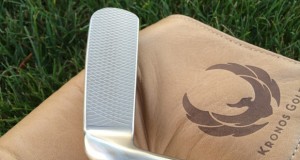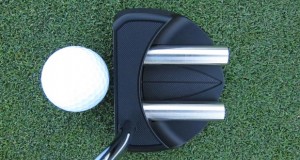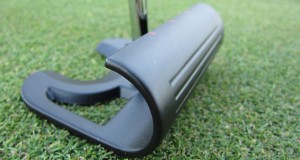 In the famous words of the movie Poltergeist:“They’re baaa-aack!”
In the famous words of the movie Poltergeist:“They’re baaa-aack!”
Indeed, the all-white Ghost putters by TaylorMade have returned for an encore with the release of the Rossa Daytona Ghost blade ($129), which is the successor to the original Rossa Corza Ghost mallet released earlier this year.
As you may recall, the original Ghost racked up millions of dollars on the PGA Tour in the hands of Justin Rose and others while helping TaylorMade make significant strides in retail putter market share. Can this new Ghost scare up as much buzz as its trailblazing predecessor? Following is PutterZone.com’s TaylorMade Rossa Daytona Ghost putter review.
The Storyline
The Rossa Corza Ghost mallet was released earlier this year to much fanfare, followed by the aforementioned success on the professional circuits and in the retail market. In fact, according to TaylorMade, the Corza Ghost fueled “record-breaking growth” for the company in the putter category, giving the brand a 13.1 percent dollar market share in July—the highest total in company history.
From the start, it was fairly obvious that the mallet wasn’t just a one-off product, but rather the beginning of a new line of all-white putters that would fall under the Ghost banner.
And it’s no surprise that the second release in the Ghost series is the Daytona model, which is TaylorMade’s longtime riff on the popular Anser-style blade design. In fact, TaylorMade Daytona Ghost sightings have been reported for several months on the professional circuits, and Paula Creamer even won the U.S. Women’s Open with a custom Daytona Ghost. It was just a matter of time before the rest of us mortals got a chance to give it a whirl.
According to TaylorMade, the Rossa Daytona Ghost is “a tour-proven blade that offers the familiar calming white color and high-contrast alignment cues of the now-famous Corza Ghost mallet.”
(Unlike the mallet however, the Daytona Ghost has less girth, fewer alignment lines and no ball-shaped cutout in the flange—it’s a straight-up, Anser-style blade with a single black sightline.)
So why the white finish in the first place? In analyzing more than 25,000 putts of some of the top players, TaylorMade found that 65 percent of them were plagued with alignment issues, confirming the worst-kept secret in putting: alignment is a scourge that can bedevil even the best of golfers.
So, with help from the school of optometry at the University of Indiana, TaylorMade conceived the white Ghost finish for enhanced visual contrast and, thus, improved alignment reference. In order to find the “right white”—a shade that would be more calming than glaring—they endeavored to match the white of TaylorMade’s Penta TP ball.
The Rossa Daytona Ghost also features TaylorMade’s signature AGSI+ insert. According to TaylorMade, the insert’s 14 polymer-filled grooves “hold the ball briefly at impact to negate backspin and promote forwardspin for a smoother roll and more accurate results.”
The head of the Daytona Ghost is made from cast aluminum. The head weight is 345 grams, the lie angle is 70 degrees and the loft is four degrees.
 The View from PutterZone.com
The View from PutterZone.com
There’s a fair question that hangs over the head of the Daytona Ghost: If your alignment needs help to the point that a white finish is in order, maybe you shouldn’t be putting with an Anser-style blade in the first place?
But I think there’s another way to look at it…The fact is that, for better or for worse (depending on the golfer), the Anser-style blade is the most beloved shape in the putter world. Simply put, tons of golfers are essentially married to the Anser shape. So comparing the Daytona to the Ghost mallet (or any other alignment-rich putter) is, for many, a moot point.
The question then becomes: Does the Daytona Ghost bring an alignment advantage to the traditional Anser-style putter?
And I believe the answer (pardon the pun) for many will be yes. Compared to the more familiar finishes of silver and black, the white finish provides a more vivid framing of the face angle in relation to the target line, which will no doubt help some golfers establish a more consistent setup for more consistent results. The black sightline really stands out against the white finish as well, adding to the enhanced sense of alignment reference.
While the Corza Ghost mallet still beats the Daytona Ghost in terms of total alignment features, the Daytona Ghost gets the edge in feel. Compared to the mallet, the Daytona offers more substance and softness, and while I’m not blown away by the feel, it’s certainly an improvement.
TaylorMade earns points for offering a nice head cover with a magnetic closure (please let that be a lesson to other putter makers still using Velcro closures on putters costing twice the price of the Daytona Ghost). Oddly, while the head cover features the term “Ghost Series,” the word Ghost doesn’t appear anywhere on the head of the putter itself.
One nitpick is the fact that the grip features a bright red Rossa icon near the bottom, right beneath where the lower thumb rests. And just below that is a shaft band featuring the same bright red icon. Both logos are quite visible as you look down the putter at address. For a putter that is ostensibly so concerned with its optical environment, such visual interruptions are incongruous and puzzling.
Among the Daytona Ghost’s best features is its price of $129, which is $30 less than the mallet. There’s no pretense here of the Daytona Ghost being something it’s not. Compared to the earlier TaylorMade Daytona Core Classic putter with the same AGSI+ insert that sold for $119, you’re paying a fair $10 premium for the advantage white finish. Kudos to TaylorMade for pricing this putter to move.
 PutterZone – Best Putter Reviews
PutterZone – Best Putter Reviews




